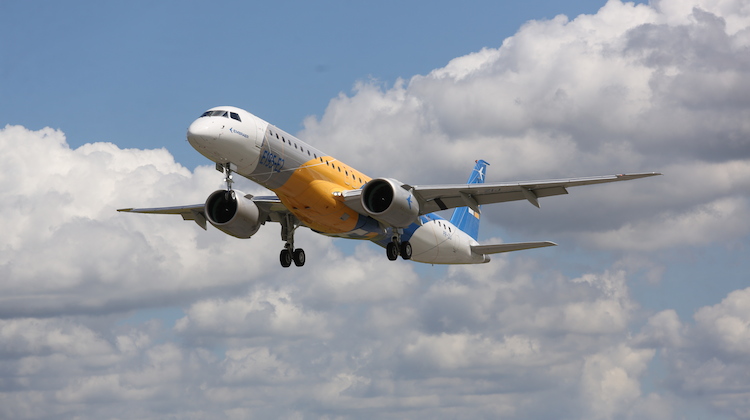
Embraer is looking ahead to its fifth decade in Australia with confidence given its lineup of regional jets stand ready to replace the large number of older generation aircraft in this part of the world.
The Brazilian aerospace giant first entered the Australian market 40 years ago, in 1978, when the EMB-110 Bandeirante went into service.
In the ensuing four decades, its commercial jets and turboprops have featured the liveries of airlines such as Airnorth, Aeropelican, Cobham Aviation Services, Hardy Aviation, King Island Airlines, Jetgo, Skippers Aviation, and Virgin Australia.
In addition to commercial aircraft, Embraer also has a number its business jets based in Australia.
Virgin Australia was the largest of operator of Embraer aircraft in this country, having flown six E170s and 18 E190 regional jets between 2007 and 2018.
The airline withdrew its E170s in 2011 and 2012, while the last E190-operated flight in Virgin Australia colours took place in February 2018.
The manufacturer’s presence in Australia was further reduced in 2018, when regional carrier Jetgo was placed in voluntary administration and Cobham returned an E190 to the lessor after three years of operations.
Embraer Commercial Aviation vice president for Asia Pacific Cesar Pereira says Australia has been a significant region for the company since the first Bandeirante landed in Brisbane in June 1978 and continues to be today.
“It’s quite a milestone, because Embraer next year we celebrate 50 years of existence,” Pereira told Australian Aviation on the sidelines of the International Air Transport Association (IATA) annual general meeting (AGM) in Sydney in early June.
“Australia has been an important and good market for Embraer.
“There is a good market now as well. There are more than 100 jets in that 100-seat segment flying in Australia from the Fokker 100, BAe 146 and 717.
“And with fuel prices picking up now – a couple of years ago a lot of people said you would never see fuel prices going to the US$80 a barrel level for the foreseeable future but it is happening again.
“The best hedge against a rising fuel price is a more efficient airplane.”
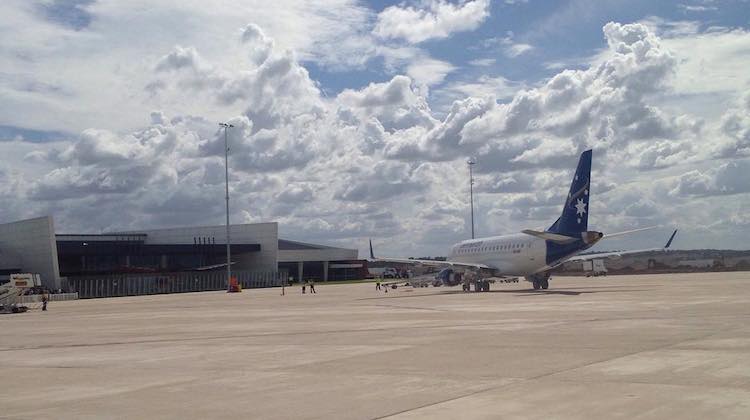
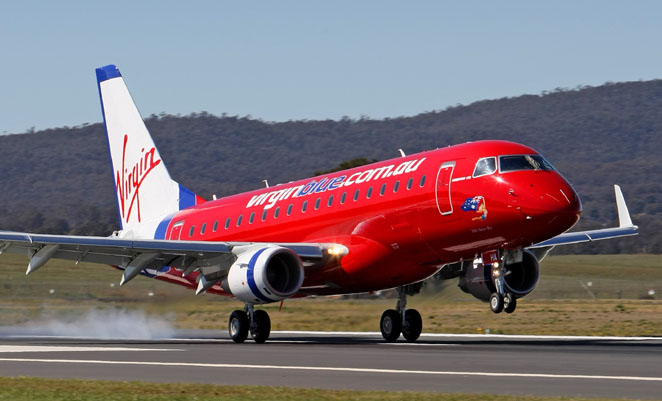
E190-E2 entered service in April
Embraer’s E-jet lineup includes the in-service E190-E2 (2,850nm range, 97-114 seats), as well as the E195-E2 (2,600nm range, 120-146 seats) and E175-E2 (2,060nm range, 80-90 seats) which are due to enter service in 2019 and 2021, respectively. The trio will be powered by Pratt & Whitney PW1700G and PW1900G geared turbofan engines.
The E2 improves on the current generation E-jets with new aerodynamically advanced, high-aspect ratio, distinctively shaped wings, improved systems and avionics, including fourth generation full fly-by-wire flight controls.
This was expected to result in double-digit reductions in fuel and maintenance costs compared with the current E-jet family. From an environmental perspective, the new aircraft also produced less emissions and less noise. The aircraft will also have a new interior with larger overhead bins and a new first class concept, among other interior improvements.
Indeed figures from Embraer showed the E190-E2’s fuel consumption was 17.3 per cent better than the current generation E190 during the flight testing program. It also said the aircraft was “nearly 10 per cent better” than the its direct competitor.
Compared to the first-generation E190, 75 per cent of the aircraft systems are new.
The E2 family of aircraft competes against the Airbus A220 regional jets – which were previously known as the C Series when the program was managed by Bombardier – and others in the up-to-150-seats segment that Embraer estimates will require 10,550 new aircraft over the next 20 years. Of those, airlines in the Asia Pacific region were expected to take delivery of 3,000 aircraft, representing the 28 per cent of total demand.
The first E190-E2 received its type certification in March, was delivered to launch customer Wideroe in April and entered service later that month.
VIDEO: The delivery ceremony of the E190-E2 on Embraer’s YouTube channel.
Embraer Commercial Aviation chief commercial officer Arjan Meijer said Wideroe had since taken delivery of a second E190-E2, with a third due shortly.
“The operation is going really well. We are very happy,” Meijer told Australian Aviation at the IATA AGM.
“With the aircraft certified now we see a lot of attraction and traction in the market, a lot of interest in the airplane and airlines want to talk about it.
“There’s a lot of airlines who want the E2, who want the new technology, who want a cleaner airplane, who want the fuel benefit, who want the more quiet cabin etc.”
Following the entry into service of the E190-E2, attention now turns to the E195-E2, which is slated to receive certification and be delivered to launch customer Azul Brazilian Airlines in the first half of 2019.
This largest member of the E2 family would be capable of flying between Sydney and Bali (2,495nm) or Sydney and Apia (2,336nm) when configured with 120 seats, as range circles from Embraer provided to Australian Aviation in 2017 showed.
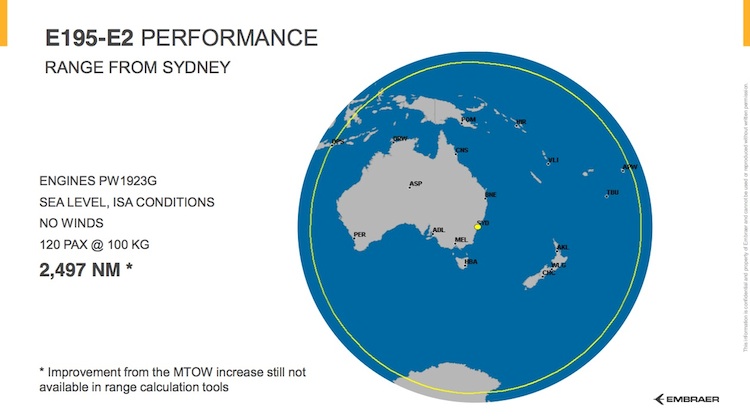
Meijer said the E195-E2 would offer airlines a step-change in operating economics given the aircraft’s cost per seat was only slightly higher than an Airbus A320 or Boeing 737.
Therefore, with fewer seats than the competing Airbus and Boeing narrowbodies, the E195-E2 offered a lower total trip cost and the opportunity to serve some marginal routes with “a lot less risk”.
“I think the big paradigm shift that we have now is we have the E195-E2 where Embraer has put all the technology and all the improvement in getting a super cost efficient plane,” Meijer said.
“We see a significant potential, especially with the E195-E2, which can offer almost 25 per cent lower trip cost compared to an A320neo or 737 MAX 8 and the seat costs are only low single digits higher.
“In the past if you would go to a smaller plane you would reduce your cost per trip and you would increase your cost per seat.
“You don’t have to do that anymore because now with the E195-E2 you can take the lower trip cost and you don’t get the penalty of the seat cost.”
The final E2 variant, the E175-E2, was due to enter service in 2021.
Embraer maintains commitment to current E-jet production
The E2 family of aircraft are in addition to current generation E170, E175, E190 and E195 E-jet variants, which will continue to be built while there is market demand for them.
“What is important to mention is the E2 and the E1, we are actually building them now on a hybrid assembly line in Brazil so we are very flexible,” Meijer said.
“Whatever the number is and what the demand is from the market, we can build both airplanes on the same line so if we have to build a few more E1s or a few more E2s we’re flexible in doing so.”
Second-hand E-jets are likely to come under consideration for replacing the older Fokker 100s, Bae 146s and Avro RJs, among others, in Australia, particularly for operators in the relatively low-cycle charter and fly-in/fly-out market.
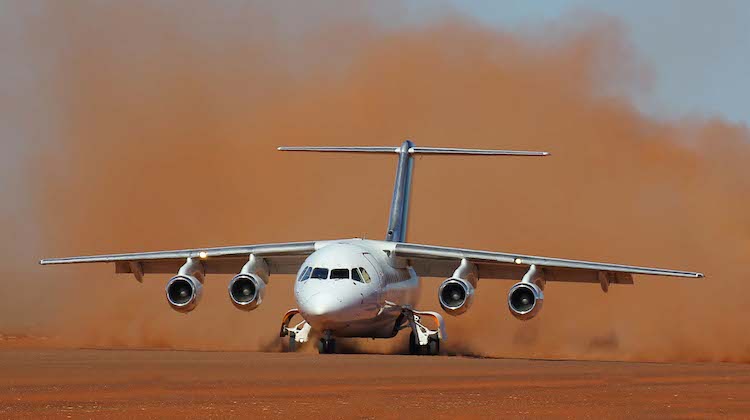
While Australia represented almost the ideal place for older aircraft to keep flying well into their third and sometimes fourth decade given the hot, dry climate across vast areas of the continent, there will come a time when even these aircraft will need to be replaced.
And Embraer is confident its E-jets will prove to be the right solution for operators of those existing airframes.
Pereira noted Embraer had delivered more than 1,400 E-jets around the world.
“We see that as a natural replacement for all this ageing fleet in Australia,” Pereira said.
“So very soon we are going to see a lot of E-jets flying in Australia. I am confident about that.”
Embraer and Boeing propose joint-venture
Since speaking with Australian Aviation, Boeing and Embraer on July 5 announced plans to establish a joint-venture that aims to boost their competitive offering in the commercial aircraft sector.
Under the Memorandum of Understanding (MoU), Boeing will purchase 80 per cent of Embraer’s commercial aircraft and services business for US$3.8 billion.
Meanwhile, Embraer will have a 20 per cent stake in the new JV.
The deal, following months of negotiations, valued Embraer’s commercial aircraft operations at US$4.75 billion.
It was expected to close at the end of 2019 and was subject to shareholder and regulatory approval, as well as the green light from the Brazil government.
The proposed tie-up from Boeing and Embraer followed Airbus acquiring a majority stake in Bombardier’s C Series program.
On July 10, Airbus announced that the C Series would be renamed the A220, with the CS100 (100-135 seats) now known as the A220-100 and the CS300 (130-160 seats) now being marketed as the A220-300.
Australian Aviation and Embraer are running a photo competition to celebrate Embraer’s 40th anniversary in Australia in 2018. For more details on how to enter, click here.











